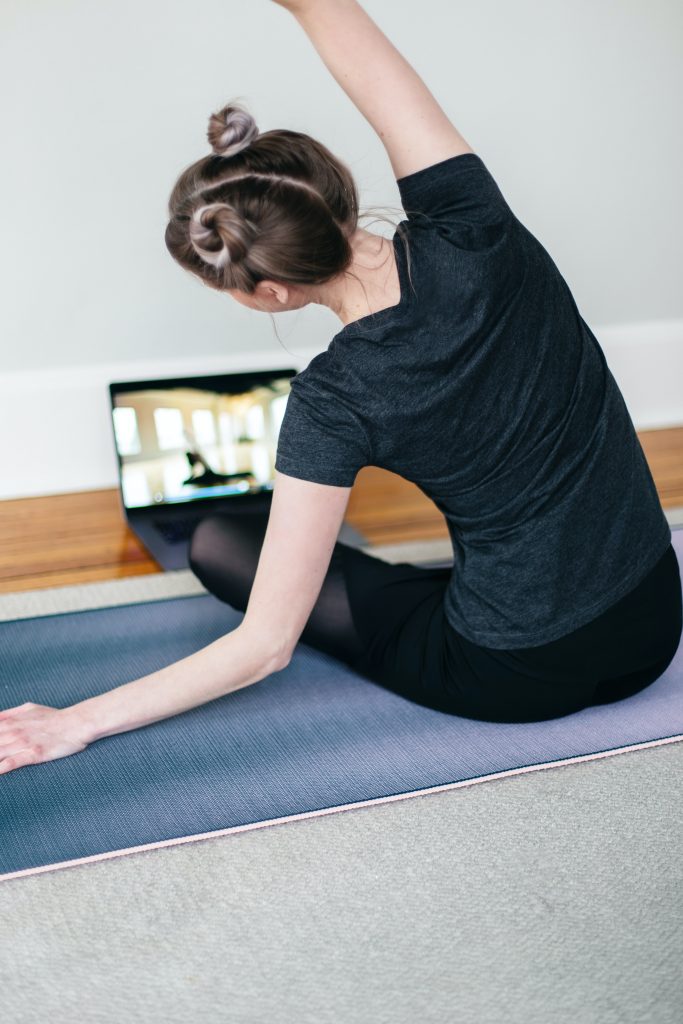
What is a warm-up?
What do you do at the start of a PE lesson or basketball match?
You do some stretching, movement and get your body ready to play. If you don’t do this then you might injure yourself. We call this doing a warm-up and warm-ups are very important in Radio Drama. A warm-up prepares your voice, body and mind for creativity and performance. This way you can feel comfortable and not damage your voice either. There are different kinds of warm-ups for different purposes.
Physical warm-ups get you ready to move and also wake you up!
But it’s Radio Drama – I don’t need to use my body, only my voice!
This is not true. The way the voice is produced is connected to our body. Think about how you sound when you wake up in the morning compared to during a PE lesson. Which ‘voice’ is stronger?
The following physical warm-ups can be done alone or in a socially-distanced setting:

Glass of Water:
Hold your hand in front of you, palm up. Imagine you have a glass of water in the palm of your hand and you do not want to spill it. Now raise your hand and twist it so that your palm is always facing up. Now twist again and bring the hand back down. Keep moving your arm around up and around and to the sides but always keep your palm up – don’t spill the imaginary water! Now do the same with the other hand. Then both hands at the same time. Make the movements bigger and try walking too. These circular movements with start to activate the muscles in your arms and torso.
Stretching your Legs and Back
Stand straight and cross your arms so that your hands on your elbows. Bend your knees slightly. Now lean forward slowly and gently bring your down so that it is hanging between your legs. Gentle swing from side to side and back and forward. Feels the tightness in your muscles and relax. Come back up slowly after about 30 seconds.

Running on the spot
Run on the spot with your feet close together. Do this for five seconds then move your feet wider. Go as fast you can! After another five seconds bring them close together again. Repeat until 30 seconds are up!
Big Me, Small Me
Stand in a neutral position (feet shoulder-width apart, hands at your side). Gradually widen your feet and arms. Reach up as high as you can and stretch. Try and be as wide as you can, then as tall as you can.
Vocal Warm-ups
Vocal warm ups prepare the voice so that it is not injured when practising and performing your Radio Drama.
Note: when doing any of these vocal warm-ups please do so carefully. If at any point you feel dizzy or uncomfortable then you must stop!

Breathing
Stand in a neutral position and place one hand on your stomach just below the ribcage. Breathein deeply and hold for five seconds, then breathe out.
- Where did you feel the air go?
- In your chest or down in your stomach?
Try again, this time when you breathe in push out your stomach and imagine the air going far down inside your body. This is using your diaphragm. Your diaphragm is a very important muscle for breathing. Using your diaphragm when breathing increases the strength or resonance of your voice. Take another five deep breaths. Feel and notice where the air goes when you breath in.
Shallow Breathing
The opposite of deep breathing. Breath in but just for a short time. Aim to keep the air in the top of your lungs. Breath in and out quickly for five seconds. It should sound as if you have just finished running a race (or a panting dog)! After five seconds pause and breathe normally. Then repeat.
Preparing the voice box
Your voice box is in your throat and is responsible for forming the sounds in your voice. You can actually feel the sounds being made. Place your hand on your voice box gently and make the following sound:
Mmmmmmmmmmmmmmmm
This is called humming. Take a deep breath and try humming for as long as you can. Repeat the exercise and this time hum louder. Keep your mouth closed! Repeat the exercises and this time go louder and then quieter. Feel the different vibrations in your voice box.
Preparing the Face, Mouth and Tongue
Your face, mouth and tongue are responsible for changing the sounds that come up from the voice box. It is important that they are also warmed up!

Face Massage
Make sure you have washed your hands! Place the tips of your fingers on your cheeks and make small circles, moving the skin around. Make the circles bigger and bigger. Move your fingertips to different parts of your face and make small circles. You can make the circles gradually bigger and bigger.
Big Mouth
Open your mouth as wide as you can. Imagine you are going to swallow a whole watermelon! Hold for five seconds and then close. Repeat five times. This stretches the side of your mouth.
Tongue Circles
Place your tongue in front of your top teeth but behind your lip. Move your tongue around the mouth, pushing hard with it. Go into the sides of the cheeks and down towards your chin. Remember your mouth should be closed! Keep doing this and change direction too. It should start to feel tired –this is good. Once it feels tired you can stop.
Chewing Invisible Gum
Imagine you have a piece of chewing gum in your mouth (or a toffee). Start to chew it (mouth closed) and move it around different parts of your mouth. Imagine the gum getting bigger and bigger until it is the size of a tennis ball. How do you chew it? Then gradually imagine it getting smaller and smaller until it disappears.
Vocal Exercises
Now it is time to combine the voice and the mouth, tongue and lips. You should start these exercises in a quiet voice and then gradually get louder.
Repeat the following sounds, as you do so pay attention to the way your mouth moves.
Ba ba ba ba ba, ba ba ba ba ba, ba ba ba ba ba ba ba ba ba ba ba ba ba!
Ca ca ca ca ca, ca ca ca ca ca, ca ca ca ca ca ca ca ca ca ca ca ca ca!
Da da da da da, da da da da da, da da da da da da da da da da da da da!
You can go through different letters in the alphabet. Exaggerate the stretches of your mouth.
Say the following sentences and pay attention to the movement of your tongue.
The lips, the teeth, the tip of the tongue
The lips, the teeth, the tip of the tongue
A good way to do this is to stand in front of a mirror. Watch the way your tongue moves. Repeat the exercise but speak slowly and exaggerate the the way you move your mouth and tongue. This exercise improves your awareness of how words are spoken.

Tongue Twisters
Tongue twisters are sentences in English that are very difficult to say. This is because your mouth and tongue need to move very quickly to new positions. Try saying the following famous tongue twisters. Start slowly and then get faster and faster, repeating the same one. Don’t worry if you make a mistake, it is totally normal! Try again!
- Red lorry, yellow lorry
- Red leather, yellow leather
- She sells seashells on the seashore
- Black bugs’ blood
- How much wood would a woodchuck chuck if a woodchuck could chuck wood?
Extra Tips for Taking Care of Your Voice
- It is important that you stay hydrated. Drink plenty of water to make sure your mouth and throat are moist.
- If your voice feels tired or painful, take a break and go back to some of the basic vocal warm-ups so you do not damage your voice.
Creative Warm-ups
Creative warm-ups are about warming up the mind by thinking in different ways and taking risks. It is important that everybody in your group feels comfortable with sharing ideas. The following warm-ups are fun and a good way to begin collaborating and sharing with your group mates.

Take a pair of chopsticks and imagine they are something else. For example, they are not chopsticks but skis! Now mime that you are skiing down a mountain using the chopsticks as skis. Your group mates will try to guess what the chopsticks have become!
Now it is somebody else’s turn. They take their chopsticks (you can all have your own pair) and mime something new:
Here are some examples to get you thinking:
- The chopsticks are antenna on an alien’s head
- The chopsticks are binoculars
- The chopsticks are a bow and arrow being fired
- The chopsticks are used for applying makeup to your face
This can be done in the classroom or on Zoom – make sure everybody can see you clearly on your camera!
Delivering Dialogue
We can change the meaning of sentences by saying them in different ways with different feelings and intentions. This warm up helps you ‘play’ with words, your voice and actions. Look at the following examples of dialogue and how they are delivered:
(surprised and happy) I can’t believe you’ve done this!
(angry and disappointed) I can’t believe you’ve done this!
The words are exactly the same but the emotion is different. This changes what we think has happened. For example, number 1 could be a mother looking at a drawing her son has done. Number 2 could be a customer shouting at a waiter who has dropped coffee on his shirt!
Take it in turns to deliver the dialogue on the left in different ways. Think about what might be happening. Other group mates can guess the situation or you can simply try to say it in as many different ways as possible.
There is no wrong answer! Have fun and experiment with them.
- I can’t believe you’ve done this!
- What did you say?
- Look at that!
- Come here.
- You know how I feel about this.
- I’m so sorry
- I’m Sam and I am your new boss.
- You are joking!
- This costs $1,000
- Take it. I don’t want it anymore.
Final Words on Warm-ups
You should try all of the warm-ups in this chapter at least once, but you don’t need to do them all in one meeting. You may discover that there are just a couple that work very well. However, do make sure that you warm up before a practice or performance. You need to protect your voice.
The goal of a warm up is not to be right, win, or do things perfectly, but to play and explore and, when you finish, you are ‘ready’ to do radio drama.
